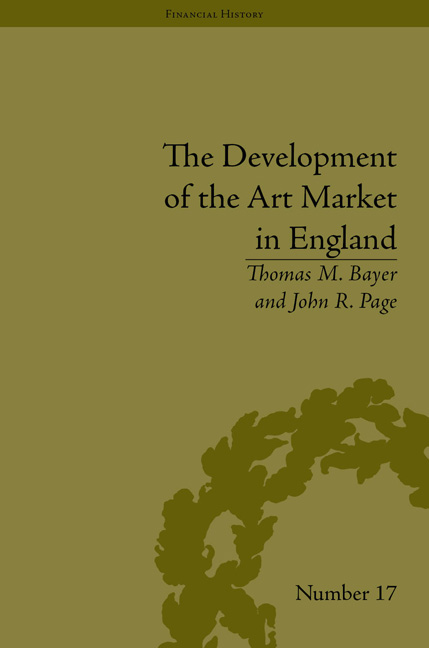Book contents
- Frontmatter
- CONTENTS
- Acknowledgements
- List of Figures and Tables
- Dedication
- Introduction
- 1 The Early Stages: From the Netherlands to Great Britain
- 2 The Commoditization of Theories of Art
- 3 The Painter as Homo Economicus
- 4 Critics and Auctions
- 5 The Evolution of Picture-Dealing
- 6 The Victorian Era
- 7 ‘Working the Oracle’: The Tools of the Trade
- 8 The Formation of a Nexus: A Story of Christie's
- 9 Commoditization and the Artist as Producer: Product Differentiation and the Domestication of Pictures
- 10 The End of the ‘Golden Age’
- 11 Postscript: A Perpetual Innovative Whirl
- Notes
- Works Cited
- Index
2 - The Commoditization of Theories of Art
- Frontmatter
- CONTENTS
- Acknowledgements
- List of Figures and Tables
- Dedication
- Introduction
- 1 The Early Stages: From the Netherlands to Great Britain
- 2 The Commoditization of Theories of Art
- 3 The Painter as Homo Economicus
- 4 Critics and Auctions
- 5 The Evolution of Picture-Dealing
- 6 The Victorian Era
- 7 ‘Working the Oracle’: The Tools of the Trade
- 8 The Formation of a Nexus: A Story of Christie's
- 9 Commoditization and the Artist as Producer: Product Differentiation and the Domestication of Pictures
- 10 The End of the ‘Golden Age’
- 11 Postscript: A Perpetual Innovative Whirl
- Notes
- Works Cited
- Index
Summary
The London publication in 1638 of Franciscus Junius the Younger's (1591–1677) De Pictura Veterum as The Painting of the Ancients brought the study of art in Britain into the domain of humanistic scholarship. The writer was an exceptionally erudite man; an intimate of Rubens, van Dyck and Inigo Jones; and also the librarian and curator for the great collector, Thomas Howard, second Earl of Arundel. His book was part treatise, part history and part oration presenting quotation after quotation, ultimately moving into philosophical discussion. The author argued that painting must be acknowledged as a liberal art, that it comes from the mind not the hands and eyes. Earlier, similar attempts by such individuals as Richard Haydocke or Lomazzo and Nicholas Hilliard, c. 1598 and 1600 respectively, to advance the social position of art had been largely unsuccessful. However, Franciscus's suggestion that knowledge of painting was a prerequisite for a gentlemanly education found a receptive audience among empiricist philosophers and others concerned with similar issues. Yet Franciscus's tome had several shortcomings. For one, it dealt with paintings no one could see, a concern raised by Rubens in a letter to the author in 1637. Furthermore, the writer's advocation of gentlemanly learning was difficult to turn into practice. Anecdotes concerning Zeuxis or other ancient painters offered few practical tools for honing one's connoisseurship.
- Type
- Chapter
- Information
- The Development of the Art Market in EnglandMoney as Muse, 1730–1900, pp. 29 - 40Publisher: Pickering & ChattoFirst published in: 2014



